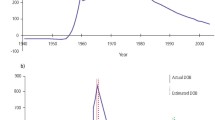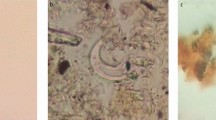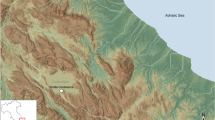Key Points
-
Highlights that the chemical composition of teeth and calculus provide evidence of the dietary components of past and present populations.
-
Stresses the genetic and cultural relationships between generations of the hominin lineage can be elucidated from dental data.
Abstract
A review of recent insights into palaeodiets provided by new dating techniques, spectroscopy and attritional wear of enamel in ancient and recent human fossils. Fossilised dental plaque reveals changing dietary content and varying oral microbiota between Neolithic and Industrial era populations. DNA analysis of ancient dental pulpal tissue provides evidence of contemporary hereditary relationships and gene flow of human populations.
Similar content being viewed by others
Main
The field of human evolution is not normally considered within the scope of dentistry, yet the very same organs upon which dentistry depends provide much of the essential evidence for human evolution. The changing anatomy of teeth over the eons reflects the changing diets dictated by the altering ambient environments in which modern mankind's predecessors survived.
That teeth are composed of the most durable tissues, enamel and dentine, ensures their postmortem survival long after all other tissues have decayed, or have been fossilised. In fact, dental enamel is a bioceramic fossilised tissue existing within us, having had its organic matrix nearly totally replaced by minerals, which, in essence, is the process of fossilisation.
It is paradoxical that the durable postmortem survival of teeth is most susceptible to decay during life, providing the dental profession its raison d'être.
The dentine component of teeth is that of ivory, surprising most people that their mouths are filled with ivory. Accordingly, the preparation of teeth for dental restorations makes dentists 'ivory carvers' on living subjects, but resembling artists sculpting ivory carvings. Finally, the pulp of teeth has become an invaluable resource of stem cells for regenerative medicine.1,2,3
The preservation of the dental pulp postmortem by virtue of its entombment within hard tissues has provided the resource for DNA identification of Neanderthal genomes.4
Teeth are unique among organs by allowing direct comparison between extant and fossilised specimens formed millions of years apart. Teeth, by their postmortem persistence, depict their genetically inherited patterns, and thus their evolutionary history, more accurately than any other organs.
The incremental deposition of enamel matrix during amelogenesis provides histological evidence of differing chronological deposition rates between apes, hominids and hominins.5 Moreover, the different rates of body maturation between these different genera has been evinced from dental data. The rapid growth of Neanderthals compared to modern humans has been deduced from comparative incremental dental data.6
Apart from the genetic evidence to be gleaned from dental morphology, significant information has been obtained about the nature of the diet, and thereby, indirectly, the cultural and evolutionary status of the propositi.7 Fossilised dental calculus entrapping pollen phytoliths and silica bodies from plants reveal the composition of food eaten two million years ago.8 Analysis of ancient calcified dental plaque revealed the dietary changes between the Neolithic and Industrial Revolutions. The changes in the oral microbiota and dietary shifts between Neolithic and Industrial era populations have been revealed by sequencing ancient calcified dental plaque (Figs 1, 2). The shift in microbial populations was concurrent with the new widespread availability of processed sugar and flour, leading to increased dental caries and gingivitis.9,10
a) The right maxilla of sample 8,482 from the medieval cemetery of the UK population Jewbury, with a large deposit of buccal calculus over maxillary molar teeth; b) Another calculus specimen from the same population showing incremental growth lines. Magnification ×50 (SEM) c) Further calculus specimen containing a colony of unidentified rod-shaped bacteria. Magnification ×3,000 (SEM). (By kind permission of Dr K. Dobney and Nature Genetics)
Further details of the diets of hominids and hominins have been extracted from dental enamel by microwear texture analysis11,12 and by isotopic analysis of enamel, revealing fundamental dietary changes in the Pliocene and subsequently.13,14,15,16 Using laser ablation mass spectrometry on dental enamel slivers allowed determination of dietary plant origins of isotopic 13C on three million year-old Australopithecus bahrelghazali individuals. Comparison with contemporary dietary plant resources revealed an early and fundamental shift in hominin dietary intake, explaining the exploration of new habitats17 and indicative of palaeoclimate change.
The advanced technology of electron spin resonance in combination with uranium series isotopic analysis and infrared/post infrared luminescence dating applied to a 500,000-year-old mandible from Serbia established the existence of a Middle Pleistocene hominin ancestral to both Neanderthals and modern humans (Fig. 3).18,19,20 DNA analyses of the teeth of 7,500-year-old and subsequent populations revealed the prehistoric gene-flow from Siberia in the complex human population history of North East Europe.21
DNA analysis of genetic identification of deceased individuals and their possible inherited relationship to living relatives is fundamental to forensic investigations. Insights into deceased historical figures and their identification by DNA analysis is being applied to the skeletal remains of the late King Richard III.22,23 Detailed isotopic and radiological analyses of the oral lesions of the Neolithic Iceman, circa 3,300 years BCE, have revealed astonishing palaeopathological information on the life and death of the Iceman.24
Dental caries undoubtedly existed at the dawn of human history, but was exceedingly rare among australopithecines and later hominins.25 The earliest known direct evidence of a dental filling in a 6,500-year old Neolithic human tooth was reported by Bernardini et al.26
The revelations of distant human ancestry revealed by teeth provide dentists, as potential recorders of our past, an expanded role in the practice of their profession.27 While the speciality of palaeodontopathology already exists, the speciality of 'Palaeodentoanthropologists' could be added as an additional attribute to the profession's already large spectrum of expertise.
References
Miura M, Gronthos S, Zhao M et al. SHED: stem cells from human exfoliated deciduous teeth. Proc Natl Acad Sci U S A 2003; 100: 5807–5812.
Granthos S, Brahim J, Li W et al. Stem cell properties of human dental pulp stem cells. J Dent Res 2002; 81: 531–535.
Huang G T, Gronthos, S, Shi S . Mesenchymal stem cells derived from dental tissues vs those from other sources: their biology and role in regenerative medicine. J Dent Res 2009; 88: 792–806.
Orlando L, Darlu P, Toussaint M, Bonjean D, Otte M, Hänni C . Revisiting Neandertal diversity with a 100,000 year old mtDNA sequence. Curr Biol 2006; 16: R400–R402.
Lacruz R S, Rozzi F R, Bromage T G . Variation in enamel development of South African hominids. J Hum Evol 2006; 51: 580–590.
Rossi F V R, deCastro J M B . Surprisingly rapid growth in Neaderthals. Nature 2004; 428: 936–938.
Lucas P, Constantino P, Wood B, Lawn B . Dental enamel as a dietary indicator in mammals. Bioessays 2008; 30: 374–385.
Henry A G, Ungar P S, Passey B et al. The diet of Australopithecus sediba. Nature 2012; 487: 90–93.
Adler C J, Dobney K, Weyrich L S et al. Sequencing ancient calcified dental plaque shows changes in oral microbiota with dietary shifts of the Neolithic and Industrial revolutions. Nat Genet 2013; 45: 450–455.
Lopez-Valverda A, Lopez-Crista M, Gomez de Diego R . Europe's oldest jaw: evidence of oral pathology. Br Dent J 2012; 212: 243–245.
Scott R S, Ungar P S, Bergstrom T S et al. Dental microwear texture analysis shows within species diet variability in fossil hominins. Nature 2005; 436: 693–695.
Lucas P W, Omar R, Al-Fadhalah K et al. Mechanisms and causes of wear in tooth enamel: implications for hominin diets. J R Soc Interface 2013; 10: 20120923. doi: 10.1098/rsif.2012.0923.
Lee-Thorp J A, Sponheimer M, Passey B H, de Ruiter D J, Cerling T E . Stable isotopes in fossil hominin tooth enamel suggests a fundamental dietary change in the Pliocene. Philos Trans R Soc Lond B Biol Sci 2010; 365: 3389–3396.
Klein R G . Stable carbon isotopes and human evolution. PNAS 2013; 110: 10470–10472.
Cerling T E, Manthi F K, Mbua E N et al. Stable isotope-based diet reconstructions of Turkana Basin hominins. PNAS 2013; 110: 10501–10506.
Sponheimer M, Alemseged Z, Cerling T E et al. Isotopic evidence of early hominin diets. PNAS 2013; 110: 10513–10518.
Lee-Thorp J, Likius A, Mackaye H T, Vignaud P, Sponheimer M, Brunet M . Isotopic evidence for an early shift to C4 resources by Pliocene hominins in Chad. PNAS 2012; 109: 20369–20372.
Rink W J, Mercier N, Mihailović M W, Morley M W, Thompson J W, Roksandic M . New radiometric ages for the BH1 Hominin from Balanica (Serbia): implications for understanding the role of the Balkans in Middle Pleistocene human evolution. PLoS One 2013; 8: e54608. doi: 10.1371/journal.pone.0054608.
Grine F E, Sponheimer M, Ungar P S, Lee-Thorp J, Teaford M F . Dental microwear and stable isotopes inform the paleoecology of extinct hominins. Am J Phys Anthropol 2012; 148: 285–317.
Roksandic M, Mihailovic D, Mercier N et al. A human mandible (BH1) from the Pleistocene deposits of Mala Balanic cave (Sićevo Gorge, Niš, Serbia). J Hum Evol 2011; 61: 186–196.
Der Sarkissian C, Balanovsky O, Brandt G et al. Ancient DNA reveals prehistoric gene-flow from Siberia in the complex human population history of North East Europe. PLoS Genet 2013; 9: e1003296. doi: 10.1371/journal.pgen.1003296.
King T . DNA identification of King Richard III. Personal Communication. Work in progress, 2013.
Rai A . Richard III the final act. Br Dent J 2013; 214: 415–417.
Seiler R, Spielman A I, Zink A, Rühli F . Oral pathologies of the Neolithic Iceman, c 3,300 bc. Eur J Oral Sci 2013; 121: 137–141.
Sperber G H . Paleodontopathology and paleodontotherapy. J Can Dent Assoc 1986; 10: 835–838.
Bernardini F, Tuniz C, Coppa A et al. Beeswax as a dental filling on a neolithic human tooth. PLoS One 2012; 7: e44904. doi: 10.1371/journal.pone.0044904.
Bailey S E, Hublin J-J (eds). Dental perspectives on human evolution: state of the art research in dental paleoanthropology. Heidelberg: Springer, 2007.
Author information
Authors and Affiliations
Corresponding author
Additional information
Refereed Paper
Rights and permissions
About this article
Cite this article
Sperber, G. The role of teeth in human evolution. Br Dent J 215, 295–297 (2013). https://doi.org/10.1038/sj.bdj.2013.878
Accepted:
Published:
Issue Date:
DOI: https://doi.org/10.1038/sj.bdj.2013.878






